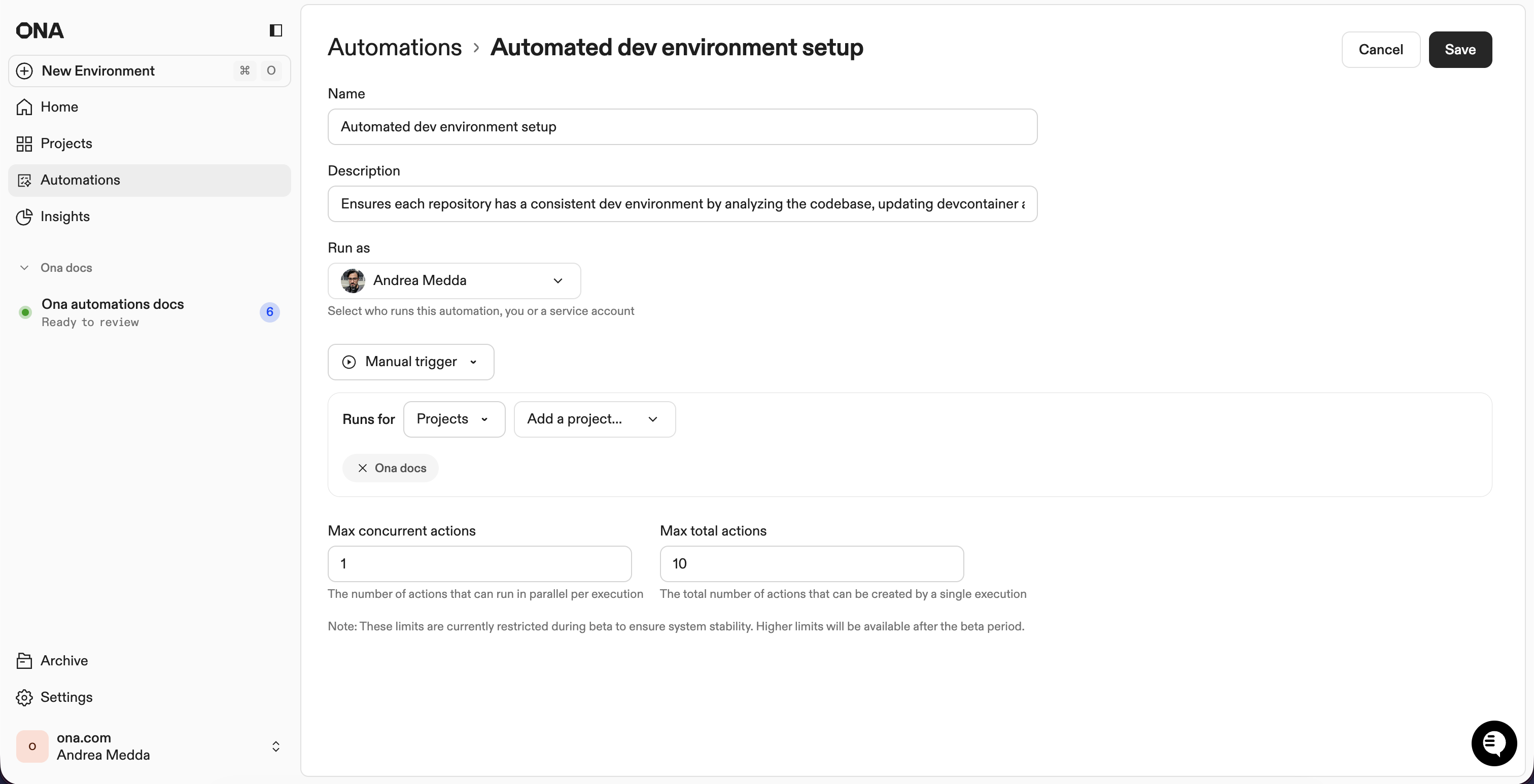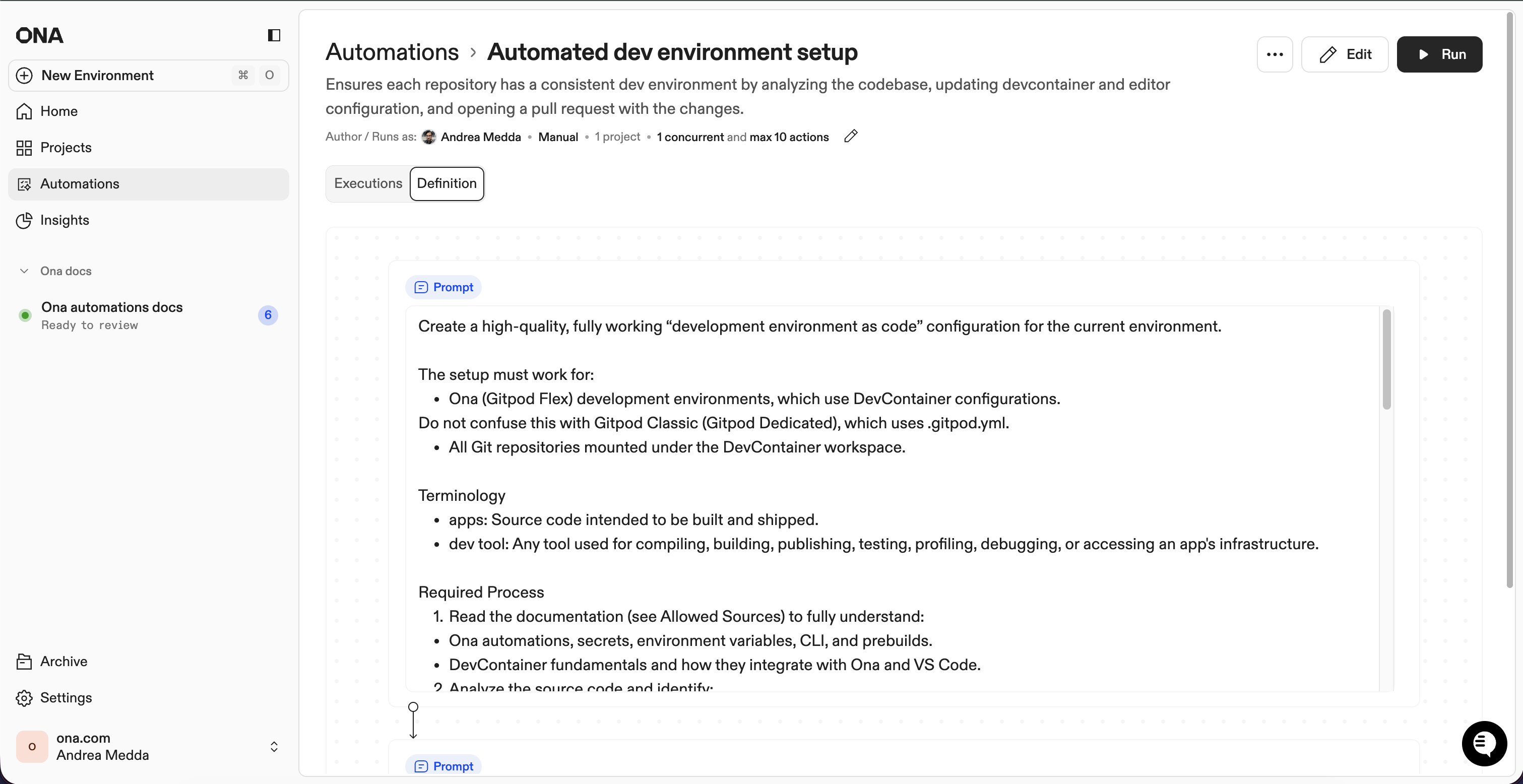Access the Automations page
- Open Ona and navigate to Automations in the left panel
- Click New Automation in the top right corner
https://app.gitpod.io/automations

Choose a starting point
Select how to create your automation:- Start from scratch - Build a custom automation from the ground up
- Use a common use case - Start with a pre-configured template (e.g., automated Dev Container setup)

Configure basic settings
Fill in the automation details:Name and description
- Name - Short, descriptive name for the automation (e.g., “Weekly dependency updates”)
- Description - Explain what the automation does
Run as
Choose who executes the automation:-
Your user - Use your own account and permissions
- Best for: Manual automations you want to own and control
- Example: One-time migrations or personal workflows
-
Service account - Use a dedicated automation account
- Best for: Event-driven automations (pull request triggers) and time-based automations (scheduled jobs)
- Example: Automated code reviews, scheduled dependency updates, or nightly builds
See Service Accounts for setup details.

Select trigger type
Choose when the automation runs. See the trigger-specific sections below for detailed configuration:- Manual - Run on demand for selected projects or repositories
- Pull Request - Trigger automatically on pull request events
- Time-based - Run on a schedule (cron)
Configure guardrails
Set limits to control automation execution and manage costs. These guardrails prevent runaway executions and help you control resource usage.- Max concurrent executions - Maximum automations running at the same time (default: 10)
- Max total executions - Maximum total executions allowed (default: 100)
- Prevent accidental large-scale runs that could impact your systems
- Manage resource allocation across your organization
- Small-scale testing (1-10 repositories): Set concurrent to 5, total to 20
- Team-level automation (10-50 repositories): Use defaults (10 concurrent, 100 total)
- Organization-wide rollout (50+ repositories): Set concurrent to 20-50, total to 500+
Steps
What are steps
Steps are executed in sequence. Each step runs in the same environment, allowing steps to build on previous work. Steps can be:- Prompts - Natural language instructions for Ona Agent
- Shell scripts - Direct commands to execute
- Pull Request steps - Automated pull request creation with customizable settings
What are prompts
Prompts are instructions written in natural language that tell Ona Agent what to do. The agent interprets the prompt and acts accordingly. When to use prompts:- Complex tasks requiring decision-making (e.g., “analyze code and suggest improvements”)
- Tasks that vary by repository structure
- When you want the agent to adapt to different scenarios
What are shell scripts
Shell scripts are executed in the automation environment by the agent. Use them for deterministic operations. When to use shell scripts:- When you need deterministic behaviour
- When you need precise control over what’s executed in the environment
- Use prompts for flexible, context-aware tasks
- Use scripts for predictable, repeatable tasks
- Combine both: scripts for setup/validation, prompts for intelligent changes
What are pull request steps
Pull request steps automatically create pull requests with your changes. Use them to submit automation results for review. When to use PR steps:- After making code changes that need review
- To create standardized PRs with consistent titles and descriptions
- When you want automation to handle the entire PR creation process
Defining multi-step workflows
Multi-step workflows let you break complex tasks into manageable pieces, with each step building on the previous one. Why use multiple steps:- Validation - Run tests between changes to catch issues early
- Clarity - Separate concerns (e.g., update code, then test, then create PR)
- Debugging - Identify exactly which step failed
- Reusability - Mix and match prompts, scripts, and PR steps
- Click Add Step
- Choose the step type
- Fill out the step details
- Repeat to add more steps

Passing data between steps
Steps run in the same environment and Ona Agent maintains context across steps. This means:- Files created by previous steps are accessible
- Environment variables set earlier persist
- Shell script outputs and results are available
- The agent remembers previous prompts and their results
- Step 1 (Prompt): “Upgrade all dependencies to their latest versions”
- Step 2 (Shell Script):
npm test(verify changes work) - Step 3 (PR Step): Create pull request with summary of changes and test results
Example configurations
Dependency upgrade with pull request:Save the automation
Click Save to create the automation. Editing automations: You can edit any automation at any time by opening it from the automations list and clicking Edit. All settings—including steps, triggers, guardrails, and targets—can be modified after creation.Webhook configuration for pull request triggers is available after saving. See Pull Request Triggers for details.